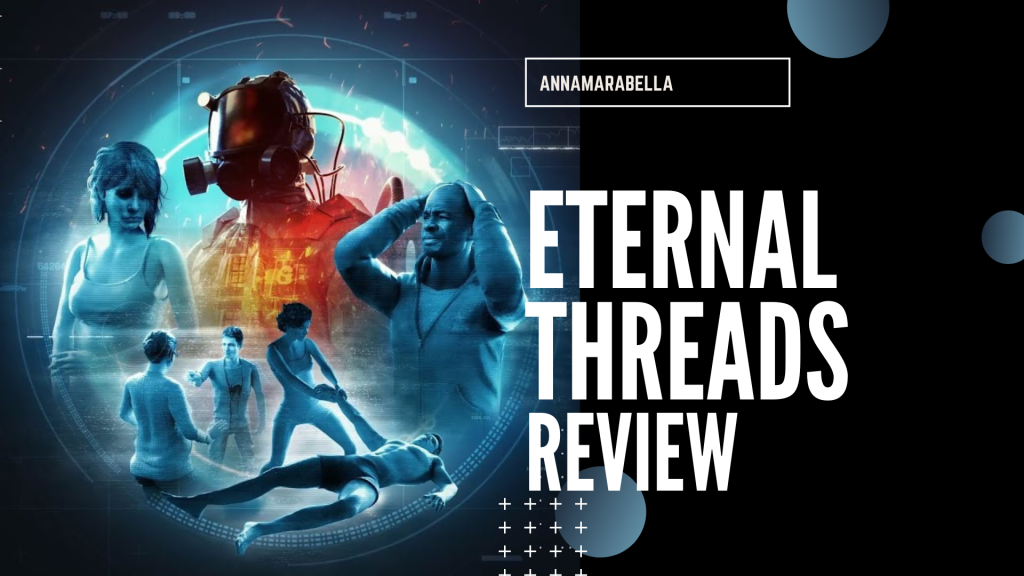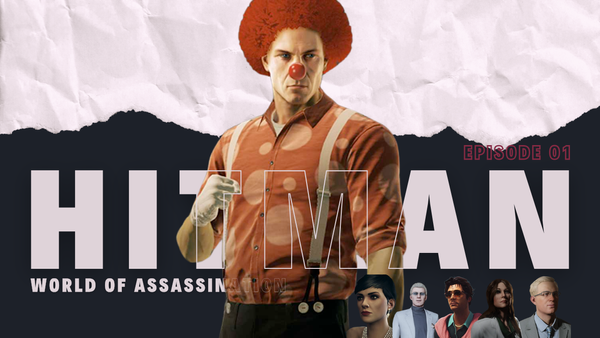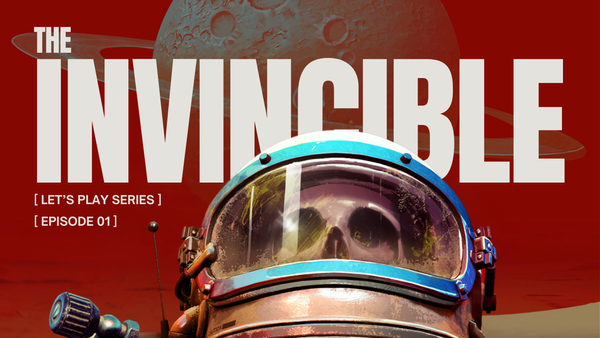Eternal Threads | Review

Eternal Threads of time, or: how to save humanity one butterfly wingflap at a time.
Eternal Threads is a single-player, first-person story-driven puzzle game of time manipulation, choice and consequence. Developed by Cosmonaut Studios, based in Liverpool, and published by Secret Mode, it was released on PS4, the Nintendo Switch, Xbox One, and PC in March, 2022 and so far has garnered very positive reviews on Steam.
I stumbled upon it more or less by accident, searching for first-person narrative games to play during a hot summer night — and Eternal Threads did keep me playing through the night this past heatwave. Completing the game in unabridged mode (and more on what that means in a moment) takes somewhere between eight and nine hours.
So, what is Eternal Threads?
You play as Agent Forty-Three, an otherwise nameless operative. A short reading at the beginning tells you that humanity have successfully effed themselves in the face by over-using time travel, setting free “chronal radiation,” derived from “chronos,” the Greek word for time, and effectively irradiating the entire planet. But not only that: futzing with time has resulted in timeline corruption. Far too many people who shouldn’t have died did die, leading to near-extinction of humanity.
Now, here’s the snag: fixing it means, you guessed it, more time travel. According to the scientists, this may well backfire and lead to humanity’s destruction, but it’s the only way. You, Agent Forty-Three, work for an unspecified entity, personified by your contact/handler: Control. Control keeps in touch with you throughout your stint in the past, feeding you information.
But Control’s voice is not the only voice you’ll hear.
Your task is to go back to May 2015, in the North of England, where your objective is to save six housemates from a deadly fire. You arrive after the catastrophe has already happened, but you have technology on your side: using a limited set of gadgets and mechanics, you’re able to visualise any event on the timeline that you can access, including alternate timeline events. This is where Eternal Threads’ strength as a puzzle game comes in: using your Visualiser, you can manipulate people’s decisions. Not every single event on the timeline includes a decision to tamper with, but all of the initially inaccessible events unlock once you change a related decision, revealing different outcomes and knowledge about the six housemates that you can use to save them.
The challenge comes in fitting all the pieces together so that not only is everyone alive — but happy. In the unabridged game mode, you draw from a larger set of decisions and events. In the abridged mode, which makes the game a little faster to play, you have fewer decisions and events at your disposal. This locks you out of achieving the best ending, however — the decisions removed from the abridged story impact the characters’ happiness, but not their survival.
I played the game in full mode on my first playthrough, and although the sheer expanse of the timeline felt daunting at first and I was expecting to say ‘done is better than perfect’ once I finally had all the housemates in the clear, the satisfaction of having the hard part done with and the curiosity about the best ending for each character made the challenge fun enough to keep going for a while longer.
Some solutions you may stumble over relatively early, while saving some of the housemates — especially Neil — comes with a good bit of sleuthing. It also depends on whether you make your way down the timeline strictly chronologically, or jump around as much as I did, starting near the end, working my way backwards to seemingly connected events, and then picking through what i hadn’t yet unlocked. Whichever way you go, the game lets you do it; nudging only here and there to give you a starting point.
The game makes interesting choices with its story — how a character’s survival can literally hinge on another person making choices that, at least in the short term, introduce even more conflict. As you go through, the story successfully relies on subtext to make the player pursue a course of events earlier in the timeline, which it takes a few go-arounds to unlock. Listen to your gut on this one, is all I can say. If you feel like you’re getting a vibe, you’re probably right. This isn’t to say the writing is ham-fisted or heavy-handed, far from it. It’s a well-judged balance between obscuring the big picture while leaving just enough hints to pick up on.
The main mystery and the way it’s tied to the game’s core mechanic is really well done. And while at the beginning it’s easy to feel overwhelmed, especially in unabridged mode, once you’ve picked a corner of the rug to gather up and shake, it falls into place like a cascade. It never felt to me like I was just haplessly connecting random dots hoping that something pings.
The framing narrative introduces a great concept — humanity is tied in a race against the clock, one that they may well lose. It’s speculative fiction with time manipulation at its core, fixing itself in an endless paradox.
The story is compelling, although the framing narrative feels a little light when it comes to one thing: motivation. I, the player, know why I’m doing this: I want to solve the mystery and save the characters — I want to complete the objective this (very good-looking, by the way) game has given me. But what about Agent Forty-Three? Why are they doing this? It’s their job, fine. But what does “restoring the timeline” in this way actually do? The player does not get to see the outcome of all their hard work beyond a screen confirming all six housemates have been saved and a short cutscene, which seems like it’s a shame, even with what the ending does hold. I won’t spoil the final twist here, but I will say that I would not mind if Cosmonaut Studios were given the chance to make a sequel to learn more about the bigger picture.
To manage expectations: the entire game is set in one house. At first, I expected some free roam, helping people in a hub world with smaller, isolated decisions that slowly begin to tie into each other. But this setup makes the gameplay and story much more complex and drives up the stakes precisely because the cast is limited and you have time to really get to know each character. Saving six people from the same catastrophic event drives your mission down to its bare essentials without losing the scope of what this single incident will contribute to — saving humanity. When it comes down to it, humanity is just… people. And each life represents a dozen futures.
One technical issue that marred the experience for me: the game is, at least on PC, struggling with a singular bug. The damn stairs. At random intervals, there’s an invisible wall blocking the player from advancing up the stairs. I found that going all the way down to the basement and then back up again resets the invisible wall and I can get further up, so it’s not game-breaking, but it is annoying.
I’m also an advocate for content warnings, and this game needs them. Please be aware that the story contains elements of unplanned pregnancy, including morning sickness. Another storyline includes somewhat graphic discussions of childhood abuse, both physical and emotional, and anger management issues. Other elements are childhood trauma, including discussions of death and grief. And then there’s a storyline that includes discussions of an unsafe dom/sub dynamic and abusive, controlling behaviour in a romantic relationship.
I don’t believe that including these warnings in this review — or, in fact, in what could have simply been a note at the beginning of the game, or on the Steam page — constitutes spoilers.
There’s a warning given on the Steam page and at the beginning of the game regarding the use of flashing imagery. The mature content description on the Steam page runs as follows:
Relationships are treated as realistic with the implicit understanding that sexual activity takes place between consenting partners. However no sexual activity is shown on-screen, with all such activity taking place off-screen, between the scenes shown in the game. The game also includes the use of bad language, tobacco, alcohol and illegal drugs.
I think that an additional note cautioning players that the game explores mature and potentially triggering themes aside from sex, swearing, and tequila would have been just fine. To be clear: I wasn’t triggered by any of the content and I am 100% for games exploring subjects like the ones above. I don’t want stories to be sanitised. I only want all readers, gamers, and listeners to be given the chance to make a fully informed decision on whether they’re going to enter into an immersive experience like this. Being blindsided by something sucks. That said, of course studios or publishers can’t anticipate everyone’s individual triggers, so that’s why I always include content warnings in my reviews, to bridge the gap.
These two issues aside, however, I wholly enjoyed my time with Eternal Threads. I haven’t unlocked every single event, and I may very well one day return to the game to 100% it. I think the game’s a credit both to the narrative-driven puzzle game and the scifi genre. The graphics look great, the art style draws from the horror genre à la Layers of Fear; and there are a few tiny horror elements that really add to the atmosphere. I absolutely recommend this game to everyone looking for an immersive, first-person mystery experience that plays with time manipulation and its consequences.
You can also watch this review on YouTube!




